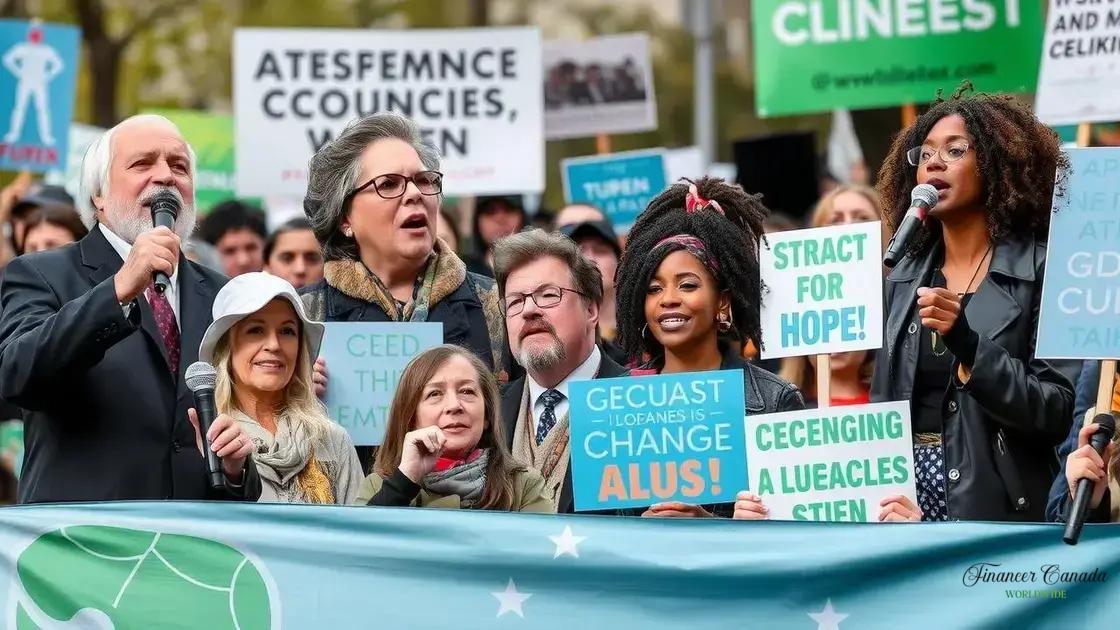Environmental activism and its impact on policy changes

Environmental activism significantly impacts policy by promoting renewable energy, advancing climate justice, and encouraging sustainable practices, thus driving legislative changes that protect the environment.
Environmental activism and its impact on policy play a crucial role in shaping our world today. Have you ever wondered how local movements influence national legislation? In this article, we’ll dive into the ways activism drives real change.
Understanding environmental activism
Understanding environmental activism is essential to see how individuals and communities advocate for sustainability. These activists play a vital role in encouraging change and advocating for policies that protect our planet. They engage in various activities, such as protests, educational campaigns, and lobbying for new laws.
What is Environmental Activism?
At its core, environmental activism seeks to address environmental issues by raising awareness and promoting changes that benefit ecological health. Activists tackle various topics, from climate change to wildlife conservation.
Methods Used by Activists
Activists use multiple approaches to reach their goals. Here are some prevalent methods:
- Grassroots campaigns that mobilize local communities.
- Advocacy through social media to spread awareness.
- Collaboration with scientists and researchers to provide evidence-based solutions.
- Organizing peaceful protests and demonstrations to capture public interest.
These methods demonstrate how diverse the strategies can be, ensuring that different voices and concerns are heard. Environmental activists also leverage technology to reach wider audiences and gain support for their causes.
Interacting with local communities helps build a stronger support base. This interaction leads to programs aimed at sustainability practices, like recycling and reducing local pollution. Additionally, educational workshops often empower individuals by teaching them how their choices affect the planet.
Why is Environmental Activism Important?
The importance of environmental activism is clear when considering its potential impact on legislation. During significant environmental events or crises, activists often raise alarms that lead to crucial policy discussions. Their ability to bring attention to pressing issues ensures that these topics remain visible.
As concerns about climate change amplify, the role of activists becomes ever more vital. They highlight the consequences of inaction and motivate both citizens and governments to act.
Whether through participation in protests or sharing information online, individuals can support these movements. Every action, no matter how small, contributes to increasing awareness and pushing for necessary change.
In summary, understanding environmental activism allows us to appreciate the impact that committed individuals and groups have on our laws and policies. The journey for a healthier planet requires collective action and heightened awareness of how we can contribute to sustainability.
Key figures in the movement

Key figures in the environmental movement have shaped our understanding of sustainability and conservation. These leaders inspire others through their dedication and innovative approaches to fighting for our planet.
Influential Activists
Many passionate individuals have emerged as strong advocates for the environment. Some of the most recognized figures include:
- Greta Thunberg: A young climate activist known for her powerful speeches and global climate strikes.
- David Attenborough: A broadcaster and natural historian who raises awareness about biodiversity and conservation.
- Jane Goodall: A primatologist and anthropologist whose work with chimpanzees highlights the importance of animal conservation.
- Wangari Maathai: The first African woman to receive the Nobel Peace Prize for her efforts in sustainable development and environmental activism through the Green Belt Movement.
These individuals have brought attention to the urgent need for climate action and have galvanized support worldwide. Their stories not only inspire hope but also mobilize communities toward important environmental initiatives.
Grassroots Leaders
Grassroots leaders often play crucial roles in local movements. They connect neighbors and community members to raise awareness and push for change. This connection is vital for mobilizing people around local issues.
Through local initiatives, these leaders often address specific environmental concerns that heavily impact their communities. They organize rallies, workshops, and educational events to engage the public. By empowering individuals, they cultivate a culture of sustainability.
A diverse range of voices strengthens the environmental movement. For instance, Indigenous leaders advocate for the protection of their lands and highlight traditional ecological knowledge. This collaboration results in innovative solutions that consider both cultural and environmental aspects. The collective efforts of these key figures emphasize the importance of unity in the fight for environmental justice.
By recognizing the contributions of these leaders, we can understand the significance of their work. Their influence serves as a reminder of the power individuals have to create change.
The role of social media in activism
The role of social media in activism has transformed how movements operate. Platforms like Twitter, Facebook, and Instagram have become essential tools for activists to connect, share, and mobilize. They allow voices that were once marginalized to participate in influential conversations.
Connecting Activists Worldwide
Social media connects people worldwide, making it easier to unite for common causes. Activists can share stories, images, and calls to action, amplifying their messages beyond local communities. This global reach helps gather support and encourages collective action.
Spreading Awareness
One of the most significant impacts of social media is its ability to spread awareness rapidly. Here’s how:
- Real-time updates keep followers informed about events and campaigns.
- Visual content, like videos and infographics, engage audiences and highlight issues effectively.
- Hashtags can organize discussions and trends, making it easier to track movements.
- Influencers and celebrities can bring attention to causes, expanding their reach.
These features demonstrate the power of social media in rallying support and driving discussions about critical issues. Activists leverage these platforms to educate others and encourage them to take part in local or global initiatives.
Online petitions gain traction through social media. These petitions allow individuals to voice their support for specific changes, which can influence lawmakers and decision-makers. With just a few clicks, people can show their support for environmental policies, animal rights, and more.
Challenges and Criticism
While the benefits are significant, social media also faces challenges. Misinformation can spread quickly, undermining activism efforts. It’s crucial for activists to verify information and counter false narratives.
Additionally, some activists may experience backlash or harassment online. This negativity can deter individuals from speaking out, highlighting the need for safer online spaces. Despite these challenges, the overall influence of social media remains strong and impactful.
Ultimately, social media enables activists to harness the power of collective voices to drive meaningful change. Its role in spreading information and connecting individuals fosters a sense of community and empowers movements worldwide.
Case studies of successful policy changes

Case studies of successful policy changes illustrate how environmental activism influences legislation. These examples highlight the power of collective action and dedication to making a difference.
California’s Plastic Bag Ban
In 2016, California made headlines by banning single-use plastic bags. This policy was the result of years of grassroots activism and public support. Advocacy groups raised awareness of the environmental harm caused by plastic waste. The campaign included petitions, community outreach, and public demonstrations.
California’s experience shows how activists can impact serious legislation. Here are some key points:
- Vigorous public education campaigns helped shape public opinion.
- Collaboration with local businesses ensured support from various stakeholders.
- The ban led to a significant reduction in plastic bag use, paving the way for similar laws in other states.
This case exemplifies how effective activism can lead to substantial policy changes that benefit the environment.
The Clean Power Plan
The Clean Power Plan, introduced in 2015, aimed to reduce carbon dioxide emissions from power plants in the United States. This plan emerged from a long history of environmental advocacy and scientific research highlighting the impacts of climate change.
Key elements of its success included:
- Influential testimonies from scientists underscored the urgency of addressing climate change.
- Mobilization of communities advocating for clean energy solutions.
- Support from various local governments that recognized the benefits of reducing emissions.
Despite facing legal challenges, the Clean Power Plan set a precedent for future policies focusing on environmental protection.
Renewable Energy Initiatives
Another prominent example includes state-level renewable energy initiatives. Several states have adopted laws promoting wind and solar energy. These policies were often championed by local activists pushing for sustainable energy solutions.
Key aspects of the movement include:
- Local advocacy raising awareness of the benefits of renewable energy.
- Community engagement leading to support for investment in clean technologies.
- Collaboration among NGOs, government, and the private sector fostering innovation in renewable energy.
These case studies demonstrate the significant impact that effective environmental activism can have on shaping policies that protect the environment and promote sustainability. Each example emphasizes not only the importance of activism but also the power of community engagement in driving legislative change.
Future trends in environmental policy
Future trends in environmental policy suggest a shift toward more inclusive and sustainable practices. As climate awareness grows, governments and organizations are increasingly focused on implementing policies that promote environmental protection and address climate change more effectively.
Emphasis on Renewable Energy
One significant trend is the increased investment in renewable energy sources. Solar, wind, and other sustainable technologies are becoming more mainstream. Countries around the world are setting ambitious goals to reduce dependence on fossil fuels.
The drive for renewable energy is influenced by:
- Innovative technologies that reduce costs and improve efficiency.
- Global agreements aimed at limiting carbon emissions.
- Public pressure for cleaner energy alternatives.
These factors create a robust environment for renewable energy initiatives, driving policy changes and leading to cleaner air and reduced greenhouse gas emissions.
Regenerative Agriculture Practices
Another emerging trend is the focus on regenerative agriculture. This approach prioritizes soil health and sustainable farming methods. By improving soil quality, farmers can increase biodiversity and create a healthier ecosystem.
Key aspects of regenerative agriculture include:
- Using cover crops to prevent soil erosion.
- Implementing crop rotation to maintain nutrient levels.
- Reducing chemical inputs to enhance natural processes.
This approach not only benefits the environment but also improves food security and farmer livelihoods. Policies supporting regenerative practices can lead to healthier food systems and reduce the negative impacts of conventional farming.
Climate Justice and Equity
Future environmental policy is increasingly recognizing the need for equity in addressing climate change. The concept of climate justice focuses on ensuring that vulnerable communities are included in decision-making processes and policy development.
This trend is driven by:
- Growing awareness of how climate change disproportionately affects low-income and marginalized groups.
- Calls for inclusive policies that protect the rights of affected communities.
- Community-led initiatives aiming for sustainability and resilience.
By prioritizing equity, future policies can foster just transitions and ensure that everyone has a voice in shaping a sustainable future.
In summary, the future of environmental policy appears promising, with trends leaning towards sustainability, justice, and inclusivity. As these practices become more integrated into the regulatory frameworks, they will help pave the way for a healthier planet.
In conclusion, the future of environmental activism and policy is filled with hope and potential. As we have seen, trends like increasing investments in renewable energy, the growth of regenerative agriculture, and a focus on climate justice are shaping a more sustainable world. By continuing to support these initiatives, we can work together to protect our planet for future generations. The power of community engagement and activism is crucial, and every action counts in this fight for our environment.
FAQ – Frequently Asked Questions about Environmental Activism and Policy
What role does social media play in environmental activism?
Social media allows activists to connect globally, spread awareness quickly, and mobilize support for environmental causes.
How does renewable energy contribute to environmental sustainability?
Renewable energy reduces reliance on fossil fuels, decreases greenhouse gas emissions, and promotes cleaner air and water.
What is regenerative agriculture, and why is it important?
Regenerative agriculture focuses on improving soil health and biodiversity, leading to a more sustainable food system and improved ecosystems.
What does climate justice mean in the context of environmental policy?
Climate justice ensures that policies address the inequities faced by marginalized communities affected by climate change, giving them a voice in decision-making.





